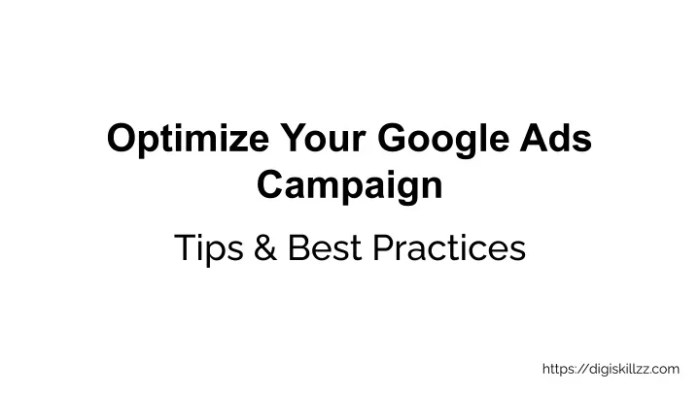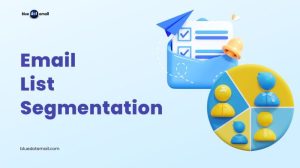
Dive into the world of Google Ads campaign optimization where e-commerce businesses thrive with strategic ad enhancements and powerful branding strategies. Let’s uncover the secrets to skyrocketing your online store’s success!
Unleash the potential of Google Ads optimization and revolutionize your e-commerce game with our expert tips and insights.
Google Ads Campaign Optimization

Optimizing Google Ads campaigns is crucial for e-commerce businesses looking to maximize their online advertising efforts and drive more sales. By fine-tuning your ads and targeting the right audience, you can improve your ad performance and increase your return on investment.
Importance of Optimization
Optimizing your Google Ads campaigns can help you reach the right audience at the right time, leading to higher conversion rates and ultimately more sales. It allows you to refine your targeting, ad copy, and bidding strategies to ensure that your ads are reaching the most relevant users.
Strategies for Improvement
- Perform research: Identify high-performing s relevant to your products or services to attract quality traffic.
- Optimize ad copy: Craft compelling ad copy that highlights your unique selling points and encourages clicks.
- Use ad extensions: Take advantage of ad extensions to provide more information to potential customers and improve ad visibility.
- Monitor performance: Regularly analyze your campaign data to identify areas for improvement and make adjustments accordingly.
Common Mistakes to Avoid
- Ignoring negative s: Failing to exclude irrelevant search terms can lead to wasted ad spend and lower conversion rates.
- Not testing different ad variations: A/B testing different ad elements can help you identify what resonates best with your audience and improve overall performance.
- Setting and forgetting: Campaign optimization is an ongoing process, so it’s important to continuously monitor and adjust your campaigns for optimal results.
Marketing E-Commerce
In the world of e-commerce, Google Ads campaign optimization plays a crucial role in helping online stores reach their target audience effectively. By fine-tuning and maximizing the performance of Google Ads, e-commerce businesses can drive more traffic to their websites and increase conversions.
Impact of Targeted Ads
Targeted ads in Google Ads can have a significant impact on driving traffic and conversions for online stores. By tailoring ad campaigns to specific demographics, interests, and behaviors of potential customers, e-commerce businesses can reach the right audience at the right time. This increases the likelihood of users clicking on the ads, visiting the website, and making a purchase. The precision of targeted ads can result in higher conversion rates and ultimately boost sales for online stores.
- Targeted ads help e-commerce businesses reach users who are more likely to be interested in their products or services, increasing the chances of conversion.
- By analyzing data and metrics from Google Ads campaigns, online stores can optimize their strategies to reach a wider audience and drive more traffic to their websites.
- Targeted ads allow e-commerce businesses to allocate their advertising budget more efficiently, focusing on reaching potential customers who are most likely to make a purchase.
Effectiveness of Google Ads Optimization
When compared to other e-commerce marketing strategies, Google Ads optimization stands out for its precision, flexibility, and ability to deliver measurable results. While , social media marketing, and email campaigns are also important for e-commerce businesses, Google Ads optimization offers unique benefits that can drive immediate and targeted traffic to online stores.
- Google Ads optimization allows e-commerce businesses to target specific s, demographics, and interests, ensuring that their ads are seen by users who are actively searching for relevant products or services.
- With Google Ads, online stores can track and analyze the performance of their campaigns in real-time, making adjustments to optimize results and maximize ROI.
- Compared to traditional advertising methods, Google Ads optimization offers a cost-effective way for e-commerce businesses to reach a global audience and compete in the online marketplace.
Advertising

Effective advertising campaigns are crucial for businesses looking to reach their target audience and drive sales. Google Ads optimization plays a significant role in enhancing the performance of advertising campaigns by improving targeting, ad relevancy, and overall campaign efficiency. By constantly monitoring and adjusting Google Ads settings, s, and ad creatives, businesses can maximize their advertising budget and achieve better results.
Relationship between Google Ads Optimization and Effective Advertising Campaigns
- Optimizing Google Ads can improve ad relevance and quality score, leading to higher ad placements and lower costs per click.
- By analyzing performance data and making data-driven decisions, businesses can optimize their advertising campaigns for better results.
- Testing different ad creatives, s, and targeting options through Google Ads optimization can help businesses identify the most effective strategies for reaching their target audience.
Examples of Successful Advertising Campaigns Driven by Optimized Google Ads
- A clothing brand increased online sales by 30% after optimizing their Google Ads campaigns to target specific demographics and geographical locations.
- A local restaurant saw a 50% increase in reservations by optimizing their Google Ads for local search intent and running promotions through the platform.
- An e-commerce store doubled its conversion rate by optimizing its Google Ads with relevant s and ad extensions to improve ad visibility.
Enhancing Brand Visibility through Google Ads Optimization
- By optimizing Google Ads for brand s, businesses can increase brand visibility and awareness among potential customers searching for their products or services.
- Utilizing Google Ads features like display advertising and remarketing can help businesses reach a wider audience and stay top of mind with potential customers.
- Continuous optimization of Google Ads campaigns can improve brand visibility by ensuring that ads are shown to the right audience at the right time, increasing brand recognition and trust.
Affiliate Marketing
Affiliate marketing is a popular strategy where businesses reward affiliates for driving traffic or sales to their website through the affiliate’s marketing efforts. Now, let’s explore how optimizing Google Ads can benefit affiliate marketing endeavors.
Optimizing Google Ads for Affiliate Marketing
When it comes to affiliate marketing, Google Ads can be a powerful tool to help increase visibility and drive conversions. Here are some tips for incorporating affiliate links within Google Ads for optimal results:
- Use targeted s: Incorporate relevant s related to the affiliate product or service to attract the right audience.
- Optimize ad copy: Craft compelling ad copy that highlights the benefits of the affiliate offering to entice users to click on the ad.
- Utilize ad extensions: Take advantage of ad extensions like sitelinks to direct users to specific landing pages with affiliate links.
- Track performance: Monitor the performance of your Google Ads campaigns to identify which strategies are driving the most affiliate conversions.
Google Ads optimization plays a crucial role in maximizing affiliate marketing revenue by increasing visibility, driving targeted traffic, and ultimately boosting conversions. By implementing the right strategies and continuously optimizing your campaigns, you can enhance the success of your affiliate marketing efforts through Google Ads.
Branding
Building a strong brand presence is crucial for any business looking to establish credibility and loyalty among its target audience. Google Ads campaign optimization plays a key role in this process by ensuring that the brand’s message is effectively communicated to the right audience at the right time. By targeting specific s, demographics, and interests, businesses can create ad campaigns that resonate with their target market, ultimately leading to increased brand awareness and recognition.
Examples of Successful Branding with Google Ads
- Apple: Apple has successfully used Google Ads to promote its products, focusing on sleek design, innovation, and user experience to establish itself as a premium brand in the tech industry.
- Nike: Nike’s strategic use of Google Ads has helped the brand connect with athletes and fitness enthusiasts worldwide, emphasizing performance, style, and empowerment in its campaigns.
- Coca-Cola: Coca-Cola has leveraged Google Ads to reinforce its status as a leading beverage brand, emphasizing happiness, refreshment, and community in its ad messaging.
Importance of Brand Consistency in Ad Campaigns
Brand consistency is essential for maintaining a strong brand presence and building trust with consumers. When optimizing Google Ads campaigns, businesses must ensure that their messaging, imagery, and tone align with their overall brand identity. Consistent branding helps reinforce the brand’s values, mission, and personality, making it easier for consumers to recognize and connect with the brand across various touchpoints.
Direct Marketing
Direct marketing is a strategy that involves reaching out to potential customers directly, often through personalized communication. When it comes to Google Ads optimization, this platform can significantly enhance direct marketing strategies by allowing businesses to target specific audiences based on their interests, demographics, and online behaviors.
Role of Personalized Ads in Direct Marketing
Personalized ads play a crucial role in direct marketing through Google Ads. By tailoring ad content to individual users, businesses can create a more personalized and engaging experience, increasing the likelihood of conversion. Personalization can involve using dynamic insertion, customizing ad copy based on user behavior, and leveraging retargeting to reach users who have already shown interest in a product or service.
- Utilize Audience Segmentation: Divide your target audience into segments based on demographics, interests, and behaviors to create personalized ads that resonate with each group.
- Dynamic Insertion: Customize ad copy to include specific s that match users’ search queries, making the ad more relevant to their needs.
- Retargeting: Show ads to users who have visited your website or interacted with your brand in the past, reminding them of your products or services and encouraging them to take action.
Best Practices for Integrating Direct Marketing Principles into Google Ads Optimization
Integrating direct marketing principles into Google Ads optimization can help businesses maximize their advertising efforts and improve ROI. Here are some best practices to follow:
- Clear Call-to-Action: Ensure that your ads have a clear and compelling call-to-action that prompts users to take the desired action, such as making a purchase or signing up for a newsletter.
- Use A/B Testing: Experiment with different ad creatives, messaging, and targeting strategies to identify what resonates best with your target audience and optimize campaign performance.
- Monitor Performance Metrics: Track key performance indicators such as click-through rate, conversion rate, and return on ad spend to measure the effectiveness of your campaigns and make data-driven decisions.
Internet Marketing
In today’s digital age, internet marketing plays a crucial role in reaching a wider audience and driving business growth. One key aspect of internet marketing is Google Ads optimization, which can significantly impact the success of marketing campaigns.
Significance of Google Ads Optimization
Google Ads optimization is essential in internet marketing campaigns as it allows businesses to target specific audiences based on demographics, interests, and online behavior. By optimizing Google Ads, businesses can increase visibility, drive traffic to their websites, and ultimately generate leads and conversions.
- Increased Visibility: By optimizing Google Ads, businesses can ensure that their ads appear at the top of search engine results pages, increasing visibility among potential customers.
- Targeted Advertising: Google Ads allows for precise targeting, enabling businesses to reach their ideal customers based on specific criteria such as location, language, and device.
- Cost-Effective Marketing: Through optimization, businesses can improve their ad relevance and quality score, leading to lower costs per click and higher return on investment.
Data-driven decision-making is key in Google Ads optimization for internet marketing success.
Leveraging Google Ads for Targeted Marketing Initiatives
When it comes to targeted internet marketing initiatives, Google Ads provides a powerful platform for reaching the right audience at the right time. By leveraging Google Ads, businesses can tailor their ads to specific user segments, driving engagement and conversions.
- Targeting: Utilizing relevant s in Google Ads campaigns can help businesses attract users actively searching for their products or services.
- Remarketing: With Google Ads, businesses can retarget users who have previously interacted with their website, keeping their brand top of mind and encouraging repeat visits.
- Location-Based Targeting: By focusing on specific geographic regions, businesses can reach local customers and drive foot traffic to physical stores.
Personalization and relevance are key in maximizing the effectiveness of Google Ads for targeted marketing initiatives.
Role of Data Analytics in Optimizing Google Ads
Data analytics plays a crucial role in optimizing Google Ads for internet marketing success. By analyzing key metrics such as click-through rates, conversion rates, and return on ad spend, businesses can make informed decisions to improve the performance of their campaigns.
- A/B Testing: Data analytics allows businesses to conduct A/B tests to compare different ad variations and determine which performs best, leading to optimization for higher conversions.
- Performance Tracking: By monitoring and analyzing campaign performance metrics, businesses can identify areas for improvement and make adjustments to optimize their Google Ads strategy.
- ROI Analysis: Data analytics helps businesses measure the return on investment from their Google Ads campaigns, enabling them to allocate budget effectively and maximize results.
Utilizing data analytics in Google Ads optimization empowers businesses to make data-driven decisions and continuously improve their internet marketing efforts.
Mailing Lists
When it comes to marketing strategies, mailing lists play a crucial role in reaching out to potential customers. By combining mailing lists with optimized Google Ads, businesses can effectively expand their reach and increase conversion rates.
Complementing Google Ads with Mailing List Strategies
Integrating Google Ads with mailing lists can help businesses target a wider audience and enhance their marketing efforts. Here are some tips to effectively combine the two strategies:
- Sync your mailing list with Google Ads: Upload your mailing list to Google Ads to create custom audiences for targeted advertising.
- Use customer data for personalized ads: Leverage the data from your mailing list to create tailored ad campaigns that resonate with your audience.
- Retarget mailing list subscribers: Reach out to subscribers on your mailing list who may not have converted yet by retargeting them with Google Ads.
By integrating mailing lists with optimized Google Ads, businesses can create a cohesive marketing strategy that targets specific audiences and drives higher conversion rates.
Benefits of Combining Mailing Lists with Google Ads
Here are some benefits of combining mailing lists with optimized Google Ads for marketing effectiveness:
- Increased targeting precision: By using mailing list data, businesses can target specific customer segments with personalized ads for better engagement.
- Enhanced brand visibility: Combining mailing lists with Google Ads can increase brand visibility and recognition among target audiences.
- Improved conversion rates: Targeting mailing list subscribers with optimized Google Ads can lead to higher conversion rates and ROI.
Final Summary
As we wrap up our journey through Google Ads campaign optimization, remember that the key to e-commerce triumph lies in mastering these optimization techniques. Elevate your brand, boost conversions, and dominate the online market with the power of Google Ads!
Questions Often Asked
How crucial is Google Ads optimization for e-commerce success?
Optimizing Google Ads is essential for e-commerce businesses to increase visibility, drive traffic, and enhance conversions.
What are some common mistakes to avoid when optimizing Google Ads campaigns?
Avoid broad targeting, neglecting ad extensions, and failing to track and analyze campaign performance.
Can Google Ads optimization help in building a strong brand presence?
Absolutely! By optimizing ads, businesses can enhance brand visibility, reach target audiences effectively, and establish brand consistency.





